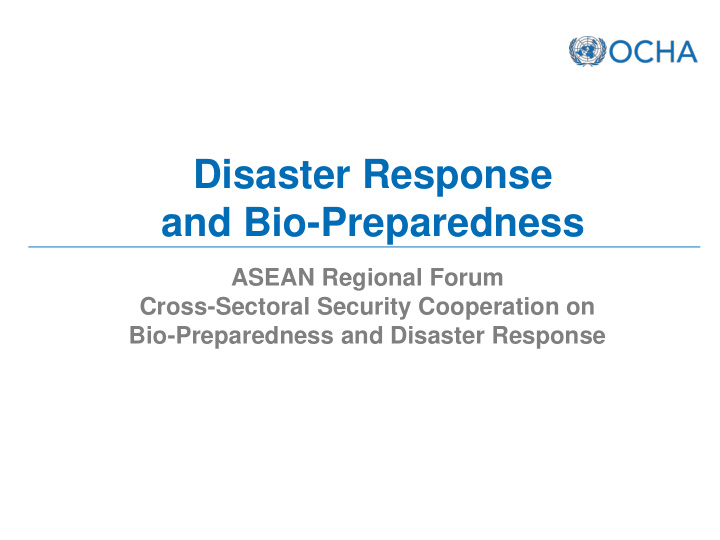



Disaster Response and Bio-Preparedness ASEAN Regional Forum Cross-Sectoral Security Cooperation on Bio-Preparedness and Disaster Response
International Humanitarian System
International Humanitarian System Humanitarian Coordination
Credit: UN Photo/Sophia Paris General Assembly Resolution 46/182 In December 1991, the General Assembly adopted resolution 46/182. It was designed to strengthen the United Nations response to complex emergencies and natural disasters, while improving the overall effectiveness of humanitarian operations in the field.
General Assembly Resolution 46/182 Creation of Emergency Relief Coordinator as a focal point for humanitarian emergencies Establishment of: • Department for Humanitarian Affairs (which became OCHA in 1998) • Inter-Agency Standing Committee • Consolidated Appeals Process • Central Emergency Credit: UN Photo/Mark Garten Revolving Fund
UN agencies • NGO consortia • Red Cross and Red Crescent • Movement IOM and international • organizations
UN Resident Coordinator (RC) • Encourages and supports national efforts in disaster risk reduction Leads and coordinates the response preparedness efforts of UNCT members and relevant humanitarian actors in support of national efforts – including contingency planning – involving all relevant stakeholders. • If international humanitarian assistance is required and a separate HC position is not established, leads and coordinates the response efforts of UN country team members and relevant humanitarian actors
Cluster Approach 1. Disaster situations 2. IDPs (from conflict)
Country-level Cluster Leads Terms of Reference Preparedness Response Coordination • Emergency • Inclusion of key Preparedness humanitarian • Planning and strategy partners development • Appropriate • Participatory and coordination community-based mechanisms approaches • Coordination with • Training and capacity- Information national authorities, building Management local civil society etc. Monitoring and Gap identification Evaluation • Advocacy and • Monitoring and resource mobilisation • reporting Attention to priority • Needs assessment cross-cutting issues and analysis (age, environment, • Application of gender, HIV/AIDS etc.) • standards Provider of last resort
Humanitarian Actors OCHA SG Donor New Govt’s ERC York OCHA WFP UNICEF Humanitarian Rome UNCS UNCS UNDP Coordinator UNHCR UNDAC IFRC USAID/ CMOC DART OSOCC MIL WFP Government Local Authority Chur urches hes NGOs Os C NGOs Os NGOs Os NGOs Os Private te
RC / HC OCHA Humanitarian Country Team NGO Country UN / International Organization Country Representative / Cross-Cutting Issues Representative Head of Agency / Country Representative Head of Cluster Lead Agency OCHA Inter-Cluster Coordination Team Cluster Cluster Cluster Cluster CC CC CC CC Coordinator Coordinator Coordinator Coordinator Clusters Clusters Clusters Clusters Cluster Members Cluster Members Cluster Members Cluster Members Humanitarian Coordination
HUMANITARIAN PROGRAMME CYCLE Humanitarian Programme Cycle Post-Crisis Transition Continued Need Analysis Humanitarian Programmes: Joint Planning Need Assessments & Analysis IMPLEMENTATION PLANNING Joint Planning: Consolidated Appeal Impact Evaluation & Lesson Learning Resource Allocation Implementation & Monitoring
Response to the Potential Humanitarian Consequences of Pandemic Influenza
Potential Impacts of a Pandemic Changed Demand Death Illness • Water and Sanitation • Access to Telecommunication Absenteeism (Phone and Internet) • Health Care Services Care Anxiety • Home-based Services • Cleaning Supplies • Cash Withdrawal • Protection against Insecurity Decreased Supply Decreased Demand • Fuel and power supply • Food Distribution • Retail Trade • Reduced production • Emergency Services • Transportation • Disrupted supply • Mortuary and Burial services • Leisure Travel • International trade of commodities • Refuse collection • Restaurant Economic and Social Disruption • Lack of Maintenance • Disrupted Supply Chain (Transportation, Rescheduling and reprioritizing of cargo flows, etc.)
Pandemic Preparedness and Response Antiviral drugs Vaccines, etc Medical Medical care, PPE actions Public Health Measures Personal hygiene Travel restrictions Non-Medical Quarantine actions Social distancing Risk Communication Food & water supply Power supply Security Social Services Transportation Telecommunication (keep a society running) other essential services (source) Dr T Kasai, WHO WPRO
CONCEPT OF OPERATIONS FOR THE UN SYSTEM IN AN INFLUENZA PANDEMIC GLOBAL LEVEL PROCEDURES WHO has responsibility for directing and coordinating the international health response to an influenza pandemic including assisting Member States with their health responses. The operational UN System agencies will contribute to the UN’s response in a pandemic according to their mandate. OCHA will coordinate responses to potential humanitarian consequences of a pandemic, in close collaboration with leads for humanitarian clusters and other partners. WHO will have overall responsibility for determining the content of public health communications to be made to Member State governments, to health professionals and to the general public
Recommend
More recommend